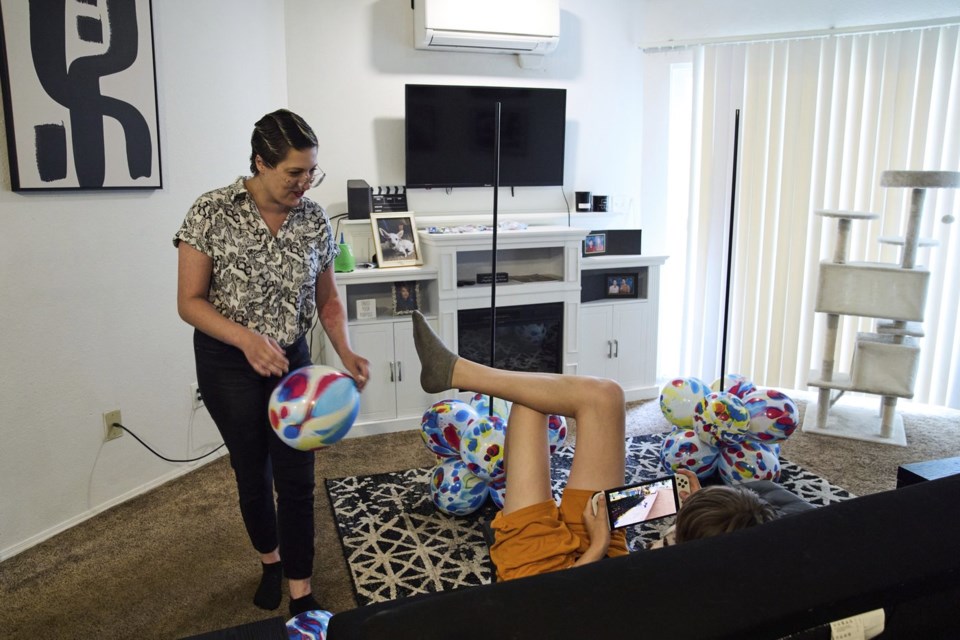WOODINVILLE, Wash. (AP) — More than 1 million low-income households — most of them working families with children — who depend on the nation’s public housing and Section 8 voucher programs could be at risk of losing their government-subsidized homes under the Trump administration’s proposal to impose a two-year time limit on rental assistance.
That’s according to new research from New York University, obtained exclusively by The Associated Press, which suggests the time restriction could affect as many as 1.4 million households helped by the U.S. Department of Housing and Urban Development.
The NYU report also raises concerns about the largely untested policy, as most of the limited number of local housing authorities that have voluntarily tried the idea eventually abandoned the pilots.
“If currently assisted households are subject to a two-year limit, that would lead to enormous disruption and large administrative costs," for public housing authorities, the report said, adding that once the limit was up, housing authorities "would have to evict all of these households and identify new households to replace them.”
Defining temporary assistance
Amid a worsening national affordable housing and homelessness crisis, President Donald Trump’s administration is determined to reshape HUD’s expansive role providing stable housing for low-income people, which has been at the heart of its mission for generations.
At a June congressional budget hearing, HUD Secretary Scott Turner argued reforms like time limits will fix waste and fraud in public housing and Section 8 voucher programs while motivating low-income families to work toward self-sufficiency.
“It’s broken and deviated from its original purpose, which is to temporarily help Americans in need,” Turner said. “HUD assistance is not supposed to be permanent.”
Elderly and disabled people would be exempted, but there’s little guidance from the agency on how time-limited housing assistance would be implemented — how it would be enforced, when the clock starts and how the exemptions would be defined.
The NYU researchers dove deep into HUD’s nationwide data over a 10-year period, analyzing nearly 4.9 million households that have been public housing and Section 8 voucher tenants. Of that, about 2.1 million could be affected by the time limits because they include at least one adult who is not elderly or disabled and about 70% of those households had already been living on those subsidies for two or more years.
HUD spokesperson Kasey Lovett pushed back on the NYU study.
“There is plenty of data that strongly supports time limits and shows that long-term government assistance without any incentive disincentivizes able-bodied Americans to work,” Lovett said in a statement.
Working families most at risk
The time limits could displace more than a million children, as it would largely punish families who are working but still earning far below their area’s median income.
“Housing assistance is especially impactful for children,” said Claudia Aiken, the director of new research partnerships for the Housing Solutions Lab at NYU's Furman Center who co-authored the study with Ellie Lochhead. Their health, education, employment and earnings potential can “change in really meaningful ways if they have stable housing,” Aiken said.
Havalah Hopkins, a 33-year-old single mom, has been living in a public housing unit outside of Seattle since 2022, but now fears a two-year time limit would leave her and her teenage son homeless. The 14-year-old boy has autism but is considered high-functioning, so how HUD defines disabled and “able-bodied” for the time limit could determine if their family will be affected by the restriction.
Hopkins, who does catering work for a local chain restaurant, pays $450 a month in rent — 30% of her household income — for their two-bedroom apartment in Woodinville, Washington.
Asked what she likes most about her home, Hopkins said: “I like that I can afford it.”
Few successful examples
Of the 17 housing authorities that tried time limits, 11 discontinued the trial. None tried two-year limits — the most common policy was a five-year limit with the option for an extra two and the limits usually applied to specific programs or referrals.
Although there are over 3,000 housing authorities in the country, only 139 of them have ever been granted flexibility to consider testing a time limit while using federal funds for programs such as job training and financial counseling.
“Any conversation about time limits ends up being this really nuanced, hyper-local focus on what works for specific communities rather than this broad national-level implementation,” said Jim Crawford, director of the Moving to Work Collaborative which oversees that group of housing authorities.
Even with those supports, several housing authorities said rent was still too high and well-paying jobs were scarce, according to the study. Others said they didn’t have enough capacity to provide enough supportive services to help households afford rent.
Shawnté Spears of the Housing Authority of the County of San Mateo in California said the agency's five-year time limits have “given folks motivation” to meet their goals in tandem with self-sufficiency programs funded by dollars Trump wants to cut. Time limits also give more households the chance to use vouchers, she said.
But with the Bay Area’s high rents, some tenants still have to spend more than half of their income on rent once their time is up or end up back on waitlists.
“I believe the program is very helpful in getting folks prepared but there lies this really, really significant rent burden here in our county,” said Spears. “When folks do leave our time-limited program, they are facing an uphill battle.”
___
Kramon reported from Atlanta.
___
Kramon is a corps member for The Associated Press/Report for America Statehouse News Initiative. Report for America is a nonprofit national service program that places journalists in local newsrooms to report on undercovered issues.
Sally Ho And Charlotte Kramon, The Associated Press



